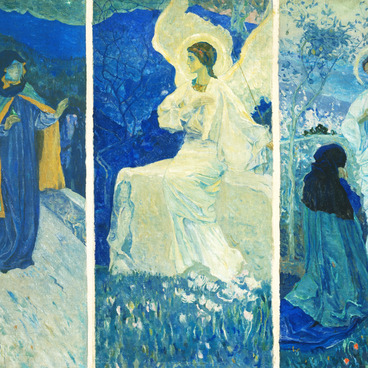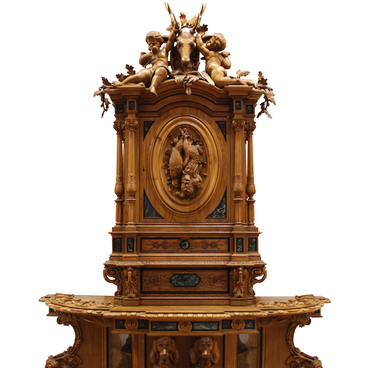The picture ‘Adam and Eve’ was painted by the Italian artist Domenico Fetti. He lived a very short life but was remembered as an original artist who initiated the rising of realistic Italian painting tendencies and created a special ‘Venetian Version of the Dutch Genre’.
Inspired by the works of Caravaggio and Rubens, Domenico Fetti studied with the Florentine painter and architect Lodovico Chigoli. The artist painted many of his favorite compositions in two or more versions, involving assistants in his work. There are analogs to the original, which are kept in the best European collections. One version of the canvas is kept in the Hermitage, the other is in London, at the Courtauld Institute of Art, the third one is in the Louvre. The first version of the painting is kept in the Tula Museum of Fine Arts, which was defined by art specialists during the study.
In 1776, in Paris, this work was purchased by Count Alexander Sergeevich Stroganov, leading statesman, educator, and collector. The purchase of this painting was recorded personally by Stroganov in the Catalog of paintings, 1793: ‘It was kept in Monsieur Biberon de Cormery’s office, from which it was given to the collection of Duc de Tallard, Marshal of France, I bought it at auction in 1756. It was transferred to canvas from panel by the famous Haken in 1772 in Paris, not without consequences to the painting.’ The painting was initially painted on panel, then transferred to the canvas together with a layer of levkas, used as a primer coat substrate for painting, which was a complicated procedure requiring consummate skill.
In his work, Domenico Fetti interpreted traditional biblical themes as everyday genre scenes. Thus, Eve, mother of humanity, is sitting under a tree, like a simple peasant, spinning yarn, surrounded by her sons, Cain and Abel. Far away, the plowman Adam cultivates the land, working hard for daily bread. The characters are dressed as ordinary Italian peasants, the artist’s contemporaries. This is a peculiar, everyday interpretation of the biblical legend expressed by Domenico Fetti in plastic and graphic means.
Inspired by the works of Caravaggio and Rubens, Domenico Fetti studied with the Florentine painter and architect Lodovico Chigoli. The artist painted many of his favorite compositions in two or more versions, involving assistants in his work. There are analogs to the original, which are kept in the best European collections. One version of the canvas is kept in the Hermitage, the other is in London, at the Courtauld Institute of Art, the third one is in the Louvre. The first version of the painting is kept in the Tula Museum of Fine Arts, which was defined by art specialists during the study.
In 1776, in Paris, this work was purchased by Count Alexander Sergeevich Stroganov, leading statesman, educator, and collector. The purchase of this painting was recorded personally by Stroganov in the Catalog of paintings, 1793: ‘It was kept in Monsieur Biberon de Cormery’s office, from which it was given to the collection of Duc de Tallard, Marshal of France, I bought it at auction in 1756. It was transferred to canvas from panel by the famous Haken in 1772 in Paris, not without consequences to the painting.’ The painting was initially painted on panel, then transferred to the canvas together with a layer of levkas, used as a primer coat substrate for painting, which was a complicated procedure requiring consummate skill.
In his work, Domenico Fetti interpreted traditional biblical themes as everyday genre scenes. Thus, Eve, mother of humanity, is sitting under a tree, like a simple peasant, spinning yarn, surrounded by her sons, Cain and Abel. Far away, the plowman Adam cultivates the land, working hard for daily bread. The characters are dressed as ordinary Italian peasants, the artist’s contemporaries. This is a peculiar, everyday interpretation of the biblical legend expressed by Domenico Fetti in plastic and graphic means.



